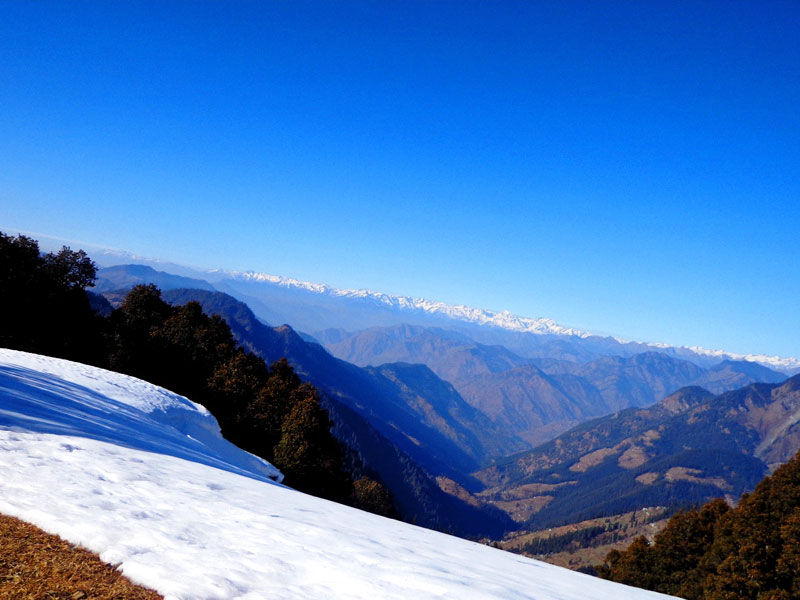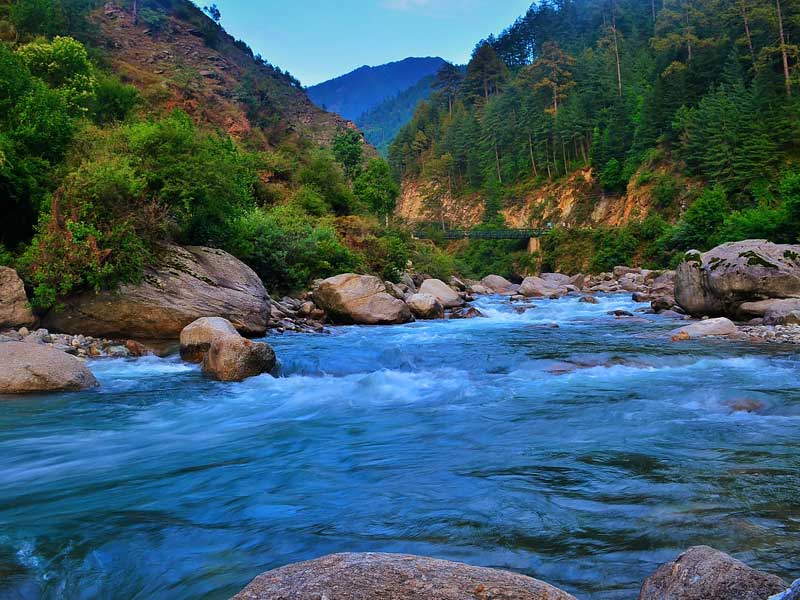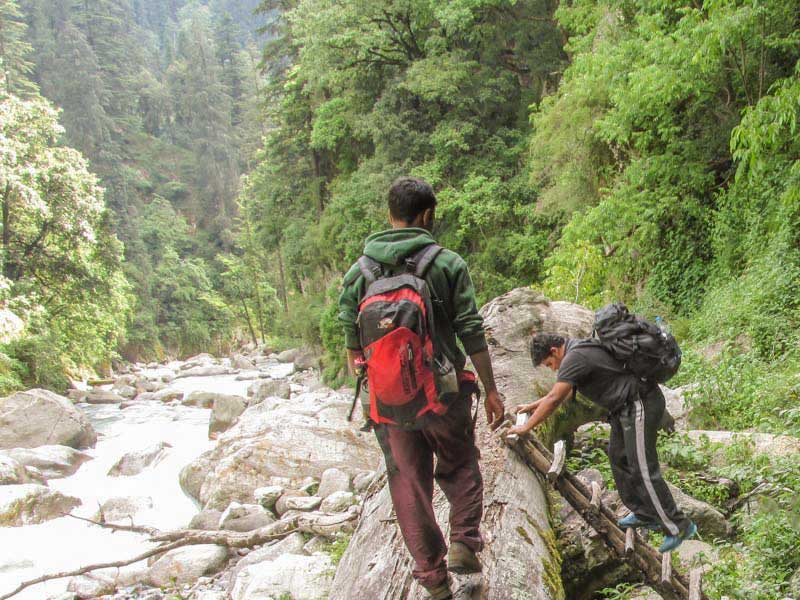Tirthan Valley, located at an elevation of approximately 1600 meters above sea level, is a riverbank hideaway gifted with a plethora of nature’s riches. Tirthan Valley, in Himachal Pradesh’s Kullu district, gets its name from the Tirthan river, which runs through it. The pure river flows from the extremely cold glacier springs of Hanskund, a snow-capped mountain in the lush Great Himalayan National Park (GHNP).
Tirthan is a unique location with something for everyone. This peaceful valley is great for walking, fishing, animal viewing, and exploring undiscovered hill communities. There’s also the option of doing nothing while relaxing among the valley’s pine trees.
So, if you enjoy exploring the unexplored territory, pack your luggage and travel to Tirthan.
About Tirthan Valley
Banjar Tirthan Valley, Banjar Valley, and About Tirthan Valley are various names for the Banjar Tehsil in Himachal Pradesh’s Kullu district. Tirthan Valley is located near Banjar town. Because the valley contains the Tirthan River, it is better known as Tirthan Valley.

Jibhi is another well-known or well-liked name from Banjar Valley. Aside from the tiny village sites, there isn’t much distinction between Banjar, Tirthan Valley, and Jibhi. Technically, all three are part of Banjar Valley, along with a few other neighboring villages. Gushaini and Jibhi are Tirthan’s two most prominent tourist destinations. Tirthan Valley is also known as Trout Fishing Valley by some.
When you visit Tirthan Valley, you will immediately experience the raw, unadulterated joy of nature, with fresh air all around you and a refreshing wind kissing your cheeks. If you enjoy outdoor hikes or trout fishing, don’t think too much about your next holiday in Himachal Pradesh. Instead, travel from Delhi to Tirthan Valley.
What is its location?
Banjar or Tirthan is located on the Jalori Pass alternative route from Kullu to Shimla. As a result, you may experience the thrilling journey over the Jalori Pass and complete the entire circle from Manali to Tirthan Valley to Shimla or Mashobra in a single trip.
Till the time you are stuck at home, see what all you can do in Tirthan Valley.
Retreat on the River
The Tirthan River flows through some of the most beautiful woods in the Western Himalayas before joining the Beas River near Larji, along National Highway 21. Several charming towns dot the river’s beautiful banks. Gushaini (8 kilometers from the Greater Himalayan National Park) and Nagini are the most popular places to stay.

Mountains Kissed by the Clouds
Tirthan Valley’s beautiful background is dominated by cloud-kissed mountains, deep coniferous woods, and expansive alpine meadows. Aside from stunning views, the valley is also one of Himachal Pradesh’s top bird viewing sites. Definitely, a fantastic place to reconnect with nature and unwind in peace!
Serolsar Lake is a tranquil setting.
The magnificent Serolsar Lake is located among the realms of rock and ice that govern the high peaks and ridges. The sparkling waters of the peaceful lake, a 6 km hike from the Jalori Pass, mirror the blue of the sky and the green of the pine forest. There is also a small shrine dedicated to Goddess Buddhi Nagin, the mother of the 60 Nag Devtas of Himachali mythology who live in Serolsar Lake.
Riverside Rustic Homes
While there are numerous places to stay in Tirthan Valley, Raju’s Guesthouse in Gushaini is a tourist destination in and of itself. This charming rustic riverside house is nestled amid fruit orchards. It is accessed by crossing the rushing Tirthan on a metal basket strung on a one-inch thick wire pulley — a terrifying but wonderfully enjoyable trip.
Secret Waterfalls
An uphill trek from Rolla town will reward you with a gem of a waterfall nestled in a wooded valley. Sit by the little waterfall and take in the ethereal atmosphere of the surroundings. A lengthier trek north will take you to Shilt, a shepherd house with a breathtaking view. In contrast, shorter hike south will take you to Khorli Pohi, the nesting grounds of the iridescent Monal bird (accessible only by special permission from the forest department).
Village Exploration
Follow the winding roads through the trees and explore the little villages of Nagini, Gushaini, Banjar, and Shoja. A visit to these hamlets is a guaranteed way to recharge your spirit, with their magnificent panoramas of rolling mountains and terrace farms, each a different shade of green. The people of these settlements are also well-known for their wood carvings, which adorn virtually all of the temples in the Kullu Valley.
Parashar Lake is pristine.
One of the most magnificent retreats in the Tirthan Valley, the Parashar Lake, reverberates with unrivaled magnificence. King Bansen built the three-story pagoda-style temple on the lake’s banks in the 14th century. The temple and lake are dedicated to Rishi Parashar, who meditated here, as the name implies.
Under the Stars Camping
Sleeping in the open on the beaches of the tranquil lakes of Serolsar and Parashar will awaken you in ways that cannot be explained. Bonfires, camping, and music beneath the starlit sky only add to the blissful atmosphere at this location, which is ideal for a well-deserved respite from the hustle and bustle of daily life.
Also Read, The never-ending journey to Spiti Valley. “Literally”
Angling Enthusiasts’ Paradise

The Tirthan River’s crystal clear glacial waters are home to an enormous population of rainbow and brown trout, making it one of India’s best-kept secret fishing spots. To preserve the river’s unique aquatic biodiversity, the Himachal government has designated the Tirthan River as an angling reserve and has decided not to allow any hydropower projects on it. A trout fishing license obtained here allows you to fish in a 45-kilometer section of the river that provides a plethora of locations for fishing enthusiasts to lay the basis for their angling.
Meadows that captivate
Shangarh is a hidden gem approximately 50 kilometers from Tirthan, accessible through the charming villages of Larji, Sainj, Neuli, and Ropa. Every visitor’s heart is captured by the Shangarh meadow’s tranquillity and unspoiled natural beauty. According to legend, the meadow was created by the Pandava brothers of the epic Mahabharat. They chose this location to build a staircase to heaven.
Weather in Tirthan Valley
The weather in Tirthan is pleasant most of the year, with summer temperatures of less than 24 degrees Celsius. Because of the running river, there is generally a cool wind. The rushing Tirthan river close to the valley ensures that there is always music in the air. The abundance of vegetation surrounding you adds to that pleasant sensation.
In the winter, the lowest temperature may dip below the freezing point, resulting in snowfall. During the peak winter months, the weather becomes dry. Snowfall is predicted in January and February, and you can always go for snow at Jalori Pass.
When is the best time to visit Tirthan Valley?

Even though Tirthan is a really peaceful, calm, relaxed, and pleasant area virtually all year. However, it is incredibly refreshing and lovely during the spring season, which lasts from March to May. Tirthan Valley’s beauty is ready to enchant every soul on the planet, thanks to its abundance of apple orchards. As a result, the spring season is the greatest time to visit Tirthan Valley.
Please keep in mind that Tirthan becomes extremely chilly in the winter and is prone to wildlife disturbance, especially with the presence of Leopards and Bears in this region. Because of the presence of snow at higher elevations, animals are forced to descend into the valley.
These leopards and bears are obliged to attack in the snow since there is less food in the highlands. So be cautious when going for a walk in the woods.





























